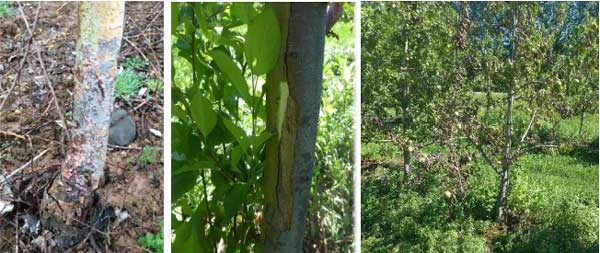Glyphosate is one of the most highly used herbicides in the world because it is economical, easy to use, broad-spectrum, and kills quickly.
Possible negative impact
A downside is that very low doses of late season applications to non-target plants may have adverse effects that are not immediately apparent, but can last for years.
These include reduced hardiness that leads to bark splitting and canker diseases, and greater susceptibility to soil borne plant pathogens.
Replicated studies on these non-target effects are still continuing throughout the USA.
Reducing plant defences
Glyphosate is a systemic herbicide that travels through the phloem (transports water and food and up and down tree organs in both directions) and accumulates in meristematic tissues (primarily in roots).
It kills plants by inhibiting the synthesis of a critical enzyme used in the shikimate pathway, which is needed for plant growth and survival.
In the soil
It is a strong chelator that binds to calcium, manganese, copper, iron, nickel, and zinc.
Although this chelating action may inhibit the growth of soil microbes that depend on these essential nutrients, it also serves to immobilize the pesticide in the soil, preventing leaching. As a result, glyphosate can accumulate in soils and perennial plants for several years.
Glyphosate–killed weeds exude small amounts of the chemical into the soil through the roots. Woody plants may absorb the chemical via root to root contact or when root hairs contact the exudate secreted from treated plants.
In the tree
Once inside a fruit tree, it may persist for several years reducing plants’ defences and leading to a variety of symptoms.
Several studies have shown that plants exposed to glyphosate are more susceptible to soil borne diseases such as Phytophthora and Fusarium.
Dr. Hannah Mathers at Ohio State University has led research on the high incidence of bark split of landscape and nursery trees. She found that bark splitting occurs when drift from late season applications is absorbed into thin or green bark of trees.
Glyphosate weakens the bark structure and reduces the hardiness of the plant. Mathers found newer formulations of glyphosate with stronger loading and wetter systems are very good at killing weeds, and also have a much stronger effect on fruit trees.
Throughout the USA, plant pathologists, fruit specialists, and apple growers have seen an increase in bark damage, dieback, and basal cankers. Based on Mathers’ research, they are now assuming that glyphosate–induced cold injury may be a culprit because affected orchards all received glyphosate applications at least once a year.
Attack by opportunistic pathogens
Many of these apple trees are being attacked by opportunistic pathogens at the point of injury, which occur as basal or stem cankers.
(Continued next issue)
See this article in Tree Fruit September 2016




















